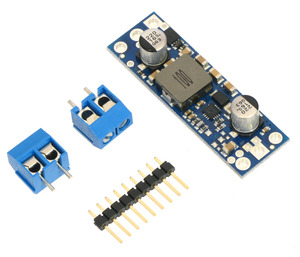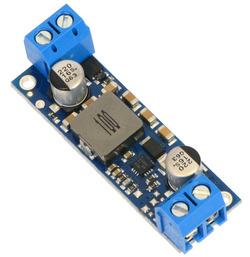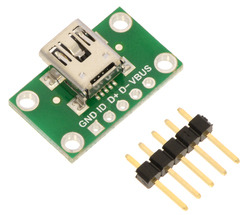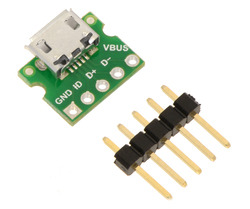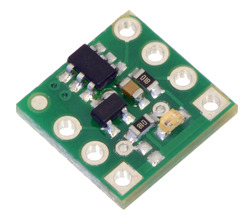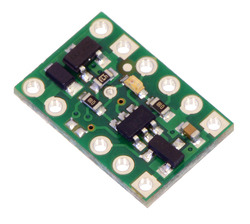Pololu Blog » User Profile: Ben » Posts by Ben »
Posts by Ben (Page 16)
You are currently viewing a selection of posts from the Pololu Blog. You can also view all the posts.
Popular tags: community projects new products raspberry pi arduino more…
Powerful new U3V50x boost regulators
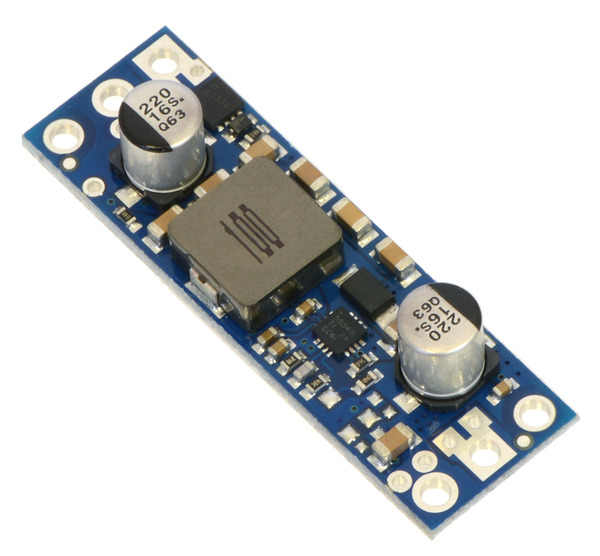 |
Ever since the release of our original adjustable boost regulators, customers have been requesting higher-power versions. Doing power systems right is not easy, and minute differences in component choices and layout can make a huge difference in performance: we went through three different failed designs before arriving at our new U3V50x family of step-up voltage regulators, which we think offers a great balance of size, performance, and price.
 |
These new boost regulators can generate up to 30 V from input voltages as low as 2.9 V while allowing for input currents as high as 5 A and offering typical efficiencies of 80% to 95%, making these our most powerful boost regulators. The regulators include built-in reverse-voltage protection, over-current protection, thermal shutdown, and an under-voltage lockout that keeps the modules from behaving erratically when the input voltage gets too low. The U3V50x family includes versions with fixed 5 V, 6 V, 9 V, 12 V, or 24 V outputs and versions with adjustable 4 V to 12 V or 9 V to 30 V outputs.
|
|
The compact boards (0.6″ × 1.9″) have two mounting holes and can be assembled with the included 5mm-pitch terminal blocks or 0.1″ header pins.
 |
For other regulator options, you can take a look at our full selection of step-up voltage regulators, step-down voltage regulators, and step-up/step-down regulators.
New product: Ultra-high-torque giant servo HD-1235MG
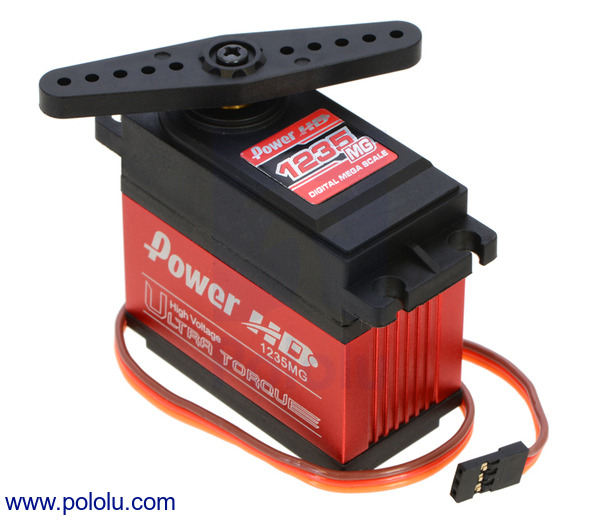 |
As you might have noticed from some of our recent blog announcements, we are steadily working on expanding our selection of hobby servos, and the latest example is Power HD’s new giant-scale (also called 1/4-scale) 1235MG servo. When compared to the popular, standard-size high-torque 1501MG servo, it is easy to see why this is called a “giant” servo:
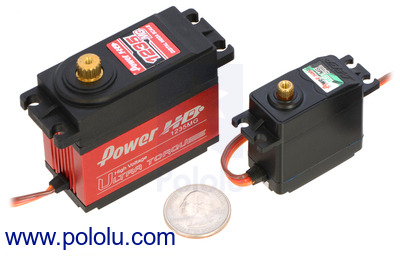 |
What you get for the increased size is increased power — a huge 560 oz-in (40 kg-cm) of torque at 7.4 V or 490 oz-in (35 kg-cm) at 6 V. Previously, if you needed more torque than our high-performance standard-size servos could deliver, our only options were the Torxis monster servos; now, the 1235MG servo helps fill that power gap.
For more information, see the 1235MG servo product page.
We have included this servo in our Black Friday sale (along with the rest of our Power HD servos) for 25% off, but the sale ends tonight at midnight (PST), so you need to hurry if you want to get it at the sale price!
Black Friday deals abound!
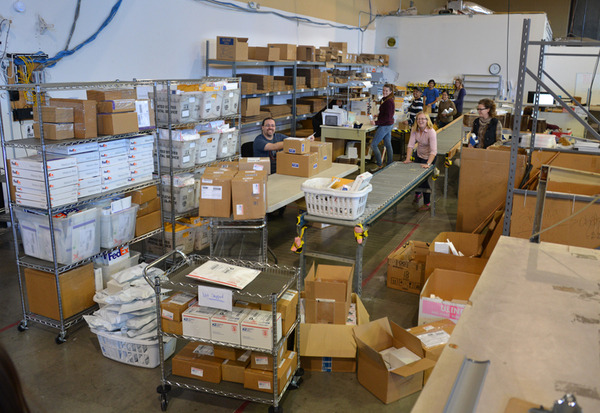 |
Pololu shipping department on Black Friday (November 29) 2013. |
|---|
Our Black Friday sale is in full swing and it is a little crazy around here. If not for the lack of snow and elves, one might be excused for mistaking our manufacturing and shipping departments for Santa’s high-tech workshop, with motor drivers fresh from the oven and that new-Zumo smell wafting through the air. Thanks to their tireless efforts, our stock levels are so far holding strong, and orders are making it out at a record pace. If you have already placed an order, thank you! If you are still trying to decide if you want to take advantage of our amazing deals, don’t wait too long—the sale ends Monday night.
In related Black Friday news, Pololu distributor Banana Robotics is having a Black Friday – Cyber Monday sale with some great deals!
And fellow purveyor of cool electronics stuff, Adafruit, is having their biggest sale ever today, with free stuff plus 10% off:
Three new high-performance Power HD servos
We are now carrying three high-performance servos from Power HD that offer an excellent combination of strength and speed for their size.
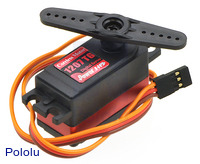 |
Power HD Low-Profile Digital Servo 1207TG – This servo is very fast and strong, despite being much shorter than a standard-size servo, making it great for applications with tight space constraints.
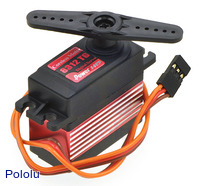 |
Power HD Digital Servo 8312TG – Much stronger than the 1207TG while nearly as fast, this servo is great for applications that require both high speed and high torque. All of the gears are made of titanium-shielded aluminum.
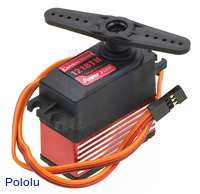 |
Power HD High-Torque, High-Voltage Digital Servo 1218TH – With a whopping 290 oz*in (21 kg*cm) of torque, this is our strongest standard-size servo, and unlike most hobby servos, it has an operating voltage range of 6 V to 7.4 V. Like the 8312TG, this servo has gears made of titanium-shielded aluminum.
All three of these servos feature coreless motors, all-metal gears, and digital control electronics, and all of them support pulse frequencies up to 333 Hz. For our full selection of Power HD servos (which are on sale right now for Black Friday for 25% off!), see our servo category.
New product: 75:1 Micro Metal Gearmotor HP with Extended Motor Shaft
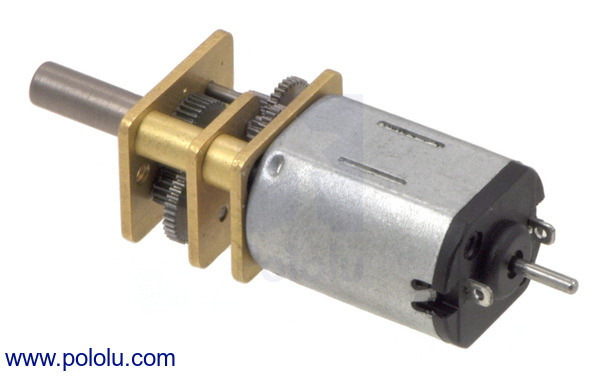 |
Our 75:1 HP micro metal gearmotor is now available with an extended motor shaft that works with our recently released optical quadrature encoders. If there are other gear ratios that you would like to see available with extended motor shafts, we would love to hear about it.
For more information on this gearmotor, see the product page. For other options, you can take a look at our full selection of micro metal gearmotors.
New product: AR-3606HB Continuous Rotation Servo
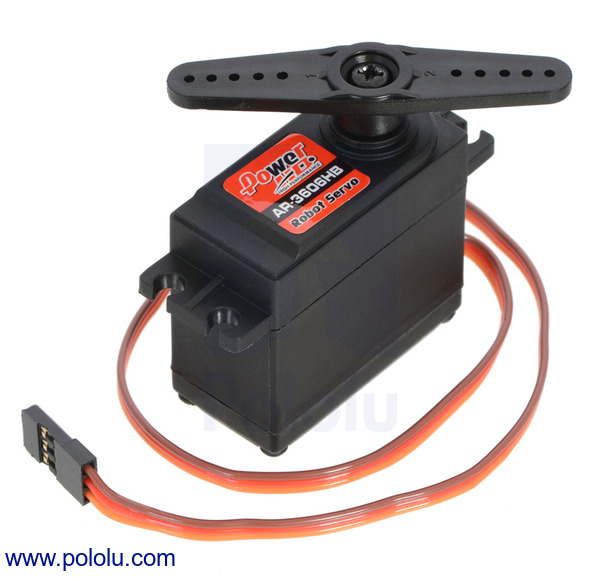 |
When properly modified for continuous rotation, hobby RC servos become an inexpensive, compact, easy-to-use actuator system for robotics projects, and servo manufacturers are increasingly answering the growing demand for such products with servos designed specifically for robots. One example is Power HD’s new AR-3606HB continuous rotation servo, which offers open-loop speed control rather than the closed-loop position control you typically get with a servo. It is the fastest and strongest continuous rotation servo we carry (up to 71 RPM and 93 oz*in of torque), with performance well suited for driving a small robot.
For more information on the AR-3606HB, see the product page. For other options, you can check out our full selection of continuous rotation servos or our entire RC servo category.
Related post: Understanding continuous-rotation servos and multi-turn servos
New products: USB Mini-B and Micro-B Connector Breakout Boards
|
|
These basic boards conveniently break out the VBUS, GND, D-, D+ and ID pins of USB Mini-B and Micro-B connectors to a set of five 0.1″-spaced pins, making it easy to power your project from a USB port or to add a USB connector to your breadboarded USB microcontroller. The compact USB Mini-B Connector Breakout Board measures 0.55" × 0.85", while the even smaller USB Micro-B Connector Breakout Board measures 0.44" × 0.5" (including the USB connectors).
Our RC Switch overhaul is complete
|
|
With the release of the new RC Switch with Digital Output and the new RC Switch with Small Low-Side MOSFET, our RC switch family overhaul is now complete. These compact modules convert hobby radio control pulses to digital on/off signals for use in RC switch and simple RC adapter applications. These products replace item #752 and item #1210, which have been put on clearance and will be discontinued when the remaining stock is gone.
For more information about these products and the rest of our RC switch family, see our RC Switch category.
Related posts:
- New product: 4-Channel RC Servo Multiplexer
- New product: RC Switch with Medium Low-Side MOSFET
- New product: Pololu RC Switch with Relay
New product: 4-Channel RC Servo Multiplexer
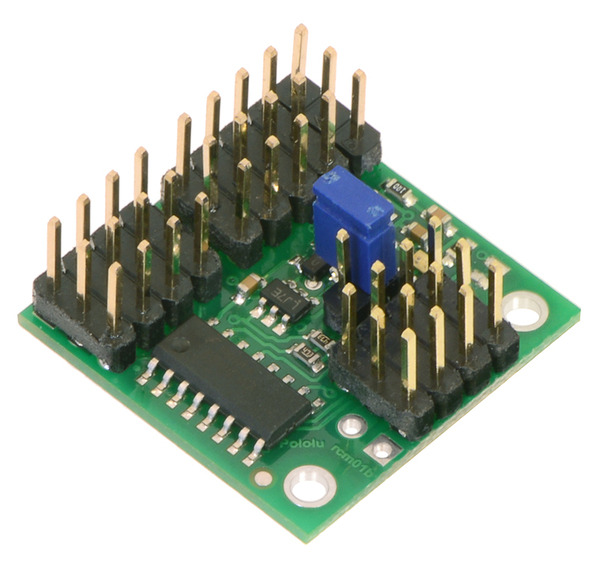 |
The overhaul of our RC switch and RC multiplexer products continues with the new Pololu 4-Channel RC Servo Multiplexer. This compact four-channel multiplexer of hobby radio control pulses allows for easy switching between two independent RC signal sources. An auxiliary channel selects whether master or slave inputs show up on the four output channels. This makes it ideal for applications in which you have two possible control sources and want to be able to switch between them on the fly.
This product replaces items #721 and #722 and includes valuable new features such as user-configurable input direction and threshold.
For more information about the new Pololu 4-Channel RC Servo Multiplexer, see the product page.
Related posts:
- Our RC Switch overhaul is complete
- New product: RC Switch with Medium Low-Side MOSFET
- New product: Pololu RC Switch with Relay
Flipbot: A Wixel-powered RC robot
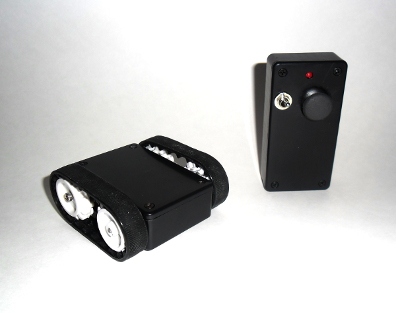 |
Geoff from Tabletop Robotics wrote a tutorial on how to build a Flipbot, a basic differential-drive robot that can keep on going even when flipped upside-down. A Wixel serves as the brains of the robot, and a second Wixel in the remote allows the Flipbot to be wirelessly controlled. In addition to the Wixels, the Flipbot uses a number of Pololu products, including:
- Two micro metal gearmotors
- 22T track set
- DRV8833 dual motor driver carrier
- MMA7361L 3-axis accelerometer
The accelerometer is used to determine when the robot is upside-down. Geoff’s tutorial has a full parts list and a diagram of how everything is connected; the complete source code is also available.
